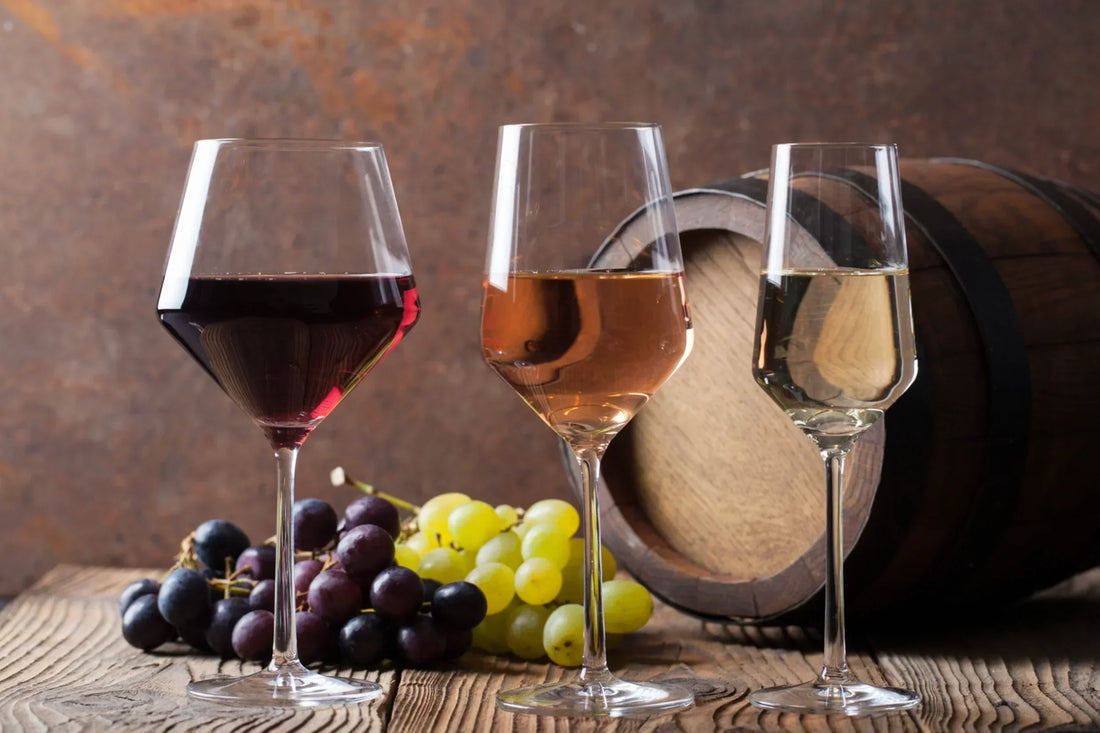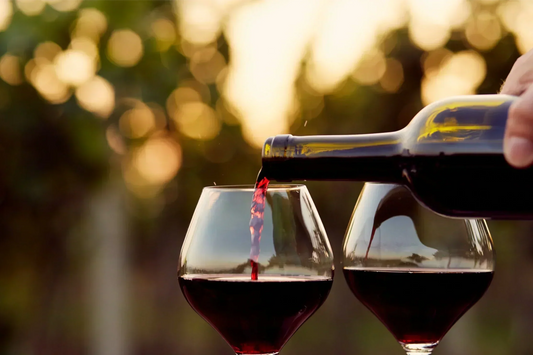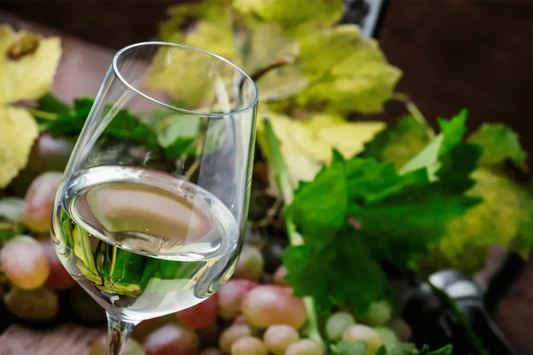
Wine Colour Chart: What Different Colours Mean & How to Read Them
When you pour a glass of wine, the very first impression often comes from its lovely colour. More than just how it looks, the wine's colour can give you insights into the grape variety, winemaking process, age, and overall style. In this guide, we'll take a look at the wine colour chart, explore what each hue signifies, and discover how these visual hints can make your wine experience even more enjoyable.
Wine Colour Chart
| Wine Colour Chart: 10 Common Shades and What They Mean | |||
|---|---|---|---|
| Wine Colour | What It Means (Age/Style) | Flavour & Structure | Example Wines |
| Purple | Very young, fruity, soft tannins | Juicy blackberries, plums, lively acidity | Gamay (Beaujolais Nouveau), young Malbec |
| Ruby | Young (under 4 years), fresh & balanced | Red berries, cherries, smooth tannins | Merlot, Grenache, Pinot Noir |
| Garnet | Oak‑aged or maturing, savoury notes | Earth, dried herbs, firmer tannins | Barolo, Rioja, aged Cabernet Sauvignon |
| Tawny | Long‑aged or fortified, mellow | Nuts, dried fruit, caramel, rounded mouthfeel | Tawny Port, very old fine reds |
| Lemon‑Green | Crisp, youthful, high acidity | Lime, green apple, zesty freshness | Sauvignon Blanc, Albariño, Vinho Verde |
| Lemon | Young aromatic whites, balanced | Citrus, pear, floral, clean finish | Pinot Grigio, Chenin Blanc, unoaked Chardonnay |
| Gold | Oak‑aged, rich, decadent | Honey, vanilla, butter, tropical fruits | Oaked Chardonnay, Viognier, Sauternes |
| Amber | Long‑aged or oxidative, complex | Nuts, caramel, oxidative character | Amontillado Sherry, aged white Rioja |
| Pink | Fruity, youthful, sometimes sweet | Strawberries, watermelon, refreshing acidity | White Zinfandel, Grenache Rosé |
| Salmon | Elegant, dry rosé | Peach, melon, floral, crisp finish | Provence Rosé, Pinot Noir Rosé |
What Is Wine Colour and Why Does It Matter?
The colour of wine is a reflection of its pigments, tannins, and the ageing process. It matters because it helps us to understand more about the wine, such as its character and quality. It can help us to:
- Indicate age: Brighter tones point to youth; deeper or browning hues suggest age.
- Predict flavour and body: Pale wines are often lighter-bodied, while deeper colours indicate greater intensity.
- Enhance tasting: Sight prepares your senses for aroma and flavour.
Factors That Influence Wine Colour
1. Grape Variety
The natural pigments in grape skins determine much of a wine’s colour. For example:
- Thick-skinned red grapes like Syrah or Malbec usually produce darker, more intense wines.
- Thin-skinned varieties such as Pinot Noir or Grenache lead to lighter, more translucent hues.
- White grapes, lacking these pigments, create wines ranging from lemon-green to deep gold depending on ripeness and handling.
2. Winemaking Process
The choices made in the cellar play a huge role in shaping colour:
- Skin contact time: Longer maceration deepens colour and adds tannins.
- Fermentation methods: Carbonic maceration, for instance, results in brighter, fruitier tones.
- Oak ageing: Contact with barrels can add golden or amber shades, while stainless steel preserves freshness.
3. Ageing and Storage
Over time, all wines evolve in colour:
- Red wines shift from vibrant purple and ruby to garnet and tawny as pigments break down.
- White wines move from lemon to deeper gold or amber through oxidation and maturation.
Storage conditions are important. Excessive light or heat speeds up browning, whereas proper cellar conditions slow it down.
Red Wine Colours
Red wines show a beautiful range of colours that shift depending on the grape variety, how they are made, and their age. These colours are not just stunning to look at but also offer hints about a wine’s fruitiness, tannin content, and how mature it is. Here are the four most common red wine shades and what they reveal.
Purple

Young and lively, purple wines typically offer juicy fruit flavours and soft tannins. They are best served fresh and showcase their youthful character in the glass.
- Flavour profile: Blackberries, plums, violets
- Structure: Light to medium body, low to moderate tannins, lively acidity
- Examples: Gamay (Beaujolais Nouveau), young Malbec, Valpolicella
Ruby

Ruby is the classic colour of many young red wines. It suggests a balance of fruit freshness and structure, making it one of the most familiar colours for everyday drinkers.
- Flavour profile: Red berries, cherries, subtle spice
- Structure: Light to full body, medium acidity, smooth tannins
- Examples: Merlot, Grenache, Pinot Noir
Garnet

As red wines age or spend time in oak barrels, they often develop garnet hues. This rich colour reflects increased complexity, inviting savoury notes and a departure from fruity flavours.
- Flavour profile: Earth, leather, dried herbs, spice
- Structure: Medium to full body, firmer tannins, developing acidity
- Examples: Barolo (Nebbiolo), Rioja (Tempranillo), aged Cabernet Sauvignon
Tawny

Tawny hues are a sign of long ageing or fortified reds. The wines are mellow, complex, and softened, often enjoyed for their depth and evolved flavours.
- Flavour profile: Nuts, dried fruit, caramel, tobacco
- Structure: Smooth, softened tannins, lower acidity, rounded mouthfeel
- Examples: Tawny Port, very old fine reds
💡 Ready to taste these styles without committing to full bottles?
Discover our roundup of 8 Best Canned Red Wines to Try (2025 Edition), an easy way to experience different red wine colours and flavours.
White Wine Colours
White wines display a spectrum of colours, from soft pale greens to rich golden and amber hues. These shades not only mirror the wine's freshness or maturity but also offer clues about its acidity, body, and the winemaking process, like oak ageing. Here are the four main shades you're most likely to enjoy encountering.
Lemon-Green

This is the hallmark of youthful, crisp white wines. The bright, green-tinged colour signals high acidity and refreshing flavours.
- Flavour profile: Lime, green apple, herbs, mineral notes
- Structure: Light body, high acidity, zesty and refreshing
- Examples: Sauvignon Blanc, Albariño, Vinho Verde
Lemon

A classic white wine shade, lemon indicates aromatic wines that are slightly riper than lemon-green but still fresh and vibrant.
- Flavour profile: Citrus, pear, white flowers
- Structure: Light to medium body, balanced acidity, clean finish
- Examples: Pinot Grigio, Chenin Blanc, unoaked Chardonnay
Gold

Gold tones usually develop through oak ageing or the use of very ripe grapes. This colour often suggests a richer, fuller style.
- Flavour profile: Honey, vanilla, butter, tropical fruits
- Structure: Medium to full body, smoother acidity, creamy texture
- Examples: Oaked Chardonnay, Viognier, Sauternes
Amber

Amber whites are often produced through long ageing or oxidative winemaking methods, which give them a rich, complex, and nutty flavour profile.
- Flavour profile: Nuts, dried fruits, caramel, toffee
- Structure: Full body, oxidative character, rounded acidity
- Examples: Sherry (Amontillado), aged white Rioja, some orange wines
💡 Want to explore crisp lemon-greens or indulgent golden whites simply?
Check out our guide to 7 Best Canned White Wines to Try (2025 Edition) and sample diverse white wine styles hassle-free.
Rosé Wine Colours
Rosé wines bridge the gap between red and white, showcasing a charming range of pink hues. The colour you see is mostly shaped by how long the grape skins touch the juice, which also hints at the wine's sweetness and flavour style. Here are the two most popular rosé shades to look out for.
Pink

A bright, youthful shade of pink often points to a fruity and approachable style, sometimes leaning towards sweetness.
- Flavour profile: Strawberries, raspberries, watermelon, candy-like notes
- Structure: Light body, refreshing acidity, sometimes off-dry
- Examples: White Zinfandel, Grenache Rosé
Salmon

Salmon-coloured rosés are typically associated with elegance and dryness, reflecting more restrained winemaking styles.
- Flavour profile: Peach, melon, floral hints, minerals
- Structure: Light to medium body, crisp acidity, dry finish
- Examples: Provence Rosé, Pinot Noir Rosé
💡 Not sure whether you’ll love a fruity pink or a dry salmon-hued rosé?
Our list of 8 Best Canned Rosé Wines to Try (2025 Edition) makes it easy to experiment and find your favourite.
Conclusion
Wine colour is more than just how it looks, but offers a charming glimpse into where a wine comes from, its style, and its personality. When you take a moment to understand these hues, you're opening the door to predicting flavours, estimating age, and making your tasting experience even more interesting. So, next time you enjoy a glass of wine, pause for a moment and appreciate its colour. It’s the first hint of all the wonderful things to come!
FAQ
1. What colour is wine?
Wine can be red, white, or rosé, with shades ranging from deep purple and ruby to pale lemon-green, golden yellow, or salmon-pink. Each colour tells you something about the wine’s style and age.
2. What does wine colour tell you about a wine?
Wine colour can reveal its age, body, grape variety, acidity, tannins, and flavour profile. For example, a pale lemon-green white wine is typically youthful and crisp, while a garnet red suggests ageing and complex savouriness.
3. How does wine colour change with age?
Red wines usually fade from purple or ruby to garnet and tawny as they mature. White wines shift from lemon-green to gold or amber hues. These changes are natural and occur due to oxidation and pigment breakdown.
4. Does darker wine mean better quality?
Not always. Darker wines may have more tannins or concentration, but lighter-coloured wines like Pinot Noir can be just as high in quality. Wine quality depends on many factors beyond colour.
5. Can I use wine colour to choose food pairings?
Yes. Colour can indicate both body and flavour strength, aiding in pairing choices. For instance, ruby reds with vibrant fruit notes complement pasta or roasted chicken, while golden whites go well with creamy dishes.



